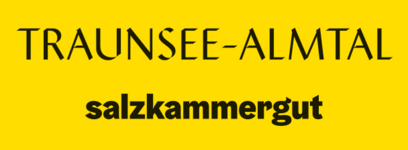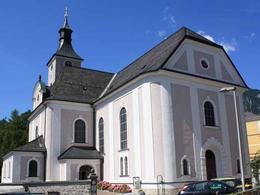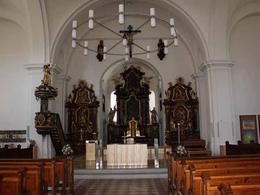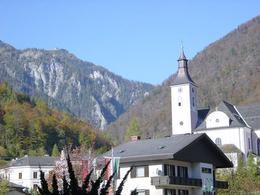Catholic parish church
4802 Ebensee

The history of Ebensee's development received a decisive boost with the start of construction of a ‘Pfannhaus’ (a salt works) in 1604, as there had only been five houses in what is now the town centre prior to this. For a long time, the town belonged to the Traunkirchen monastery.
It was not until 1726 that Emperor Charles IV approved the construction of a separate church ‘in the Lambat’. In 1729, the church, designed by the Linz Baroque architect Johann Michael Pruner and dedicated to St. Joseph, was consecrated as a branch church of Traunkirchen. It was elevated to parish status 57 years later by Emperor Joseph II (1786). In 1835, a major fire destroyed the saltworks building and the wooden church tower, which was rebuilt in solid masonry in 1841. In 1910/1911, the church was extended under the direction of cathedral architect Schlager from Linz. The parish church was last renovated between 1999 and 2004 (exterior renovation 1999–2001, interior renovation 2002–2004). The interior renovation involved radical changes in line with the renewed liturgy following the Second Vatican Council. The side altars were returned to their original locations and the side pews were turned towards the centre of the church (people's altar). The former sacristy is now a sacrament chapel.
Our organs:
In 1770, the parish church received its first small organ. As early as 1810 (or 1811), it was replaced by a larger one. The old organ was probably reused in the Calvary Church in 1813. The second organ had to be dismantled in 1910 due to the expansion of the church interior. It continues to serve in the Protestant church in Hallstatt to this day. For the next few years, a harmonium had to replace the organ until 1924, when an organ built by Ludwig Mayrhofer from Linz was procured. However, due to the economic situation, inferior minerals were used in its construction, so that a new organ had been considered since the 1960s. In 2005, an organ committee was formed with the specific aim of building a new organ. In 2012, the new organ, built by the Pirchner company from Steinach am Brenner, was installed in the old but renovated case and consecrated.
About the current design of the altar area and sacrament chapel: The Pregartner artist Herbert Friedl wanted to contrast the existing Baroque splendour with elements reduced to their simplest form. The people's altar, as the central place of the Eucharistic celebration, stands at the centre of the church, around which the celebrating congregation gathers. The wooden beams that make up the altar are intended to express the living faith community. A special feature is the processional cross: its beams are made of untreated wood from a barrack at the Mauthausen concentration camp. This is intended to remind us that during the Nazi era, one of the many subcamps of Mauthausen was located in Ebensee, where thousands of people suffered and lost their lives.
Art treasures in our parish church
High altar: late Baroque, made in Innsbruck in 1744. The wide predella bears the figures of St. Leopold and St. Charles Borromeo. The centrepiece shows the shrine image of St. Joseph, the patron saint of the church. It is an oil painting in dark brown from the Passau Cathedral Treasury by Joh. Georg Dom. Grasmair, created in 1764. The altarpiece is supported by six columns with typical late Baroque capitals. In the centre is an oil painting depicting ‘God the Father’. The strongly emphasised movement and counter-movement in the sculptural part of the altarpiece is remarkable. It reaches its greatest intensity in the two angel figures.
Side altars: Baroque, created in 1740, they are said to have come from a Tyrolean monastery, with the altar of St. Anthony on the right and the altar of St. Mary on the left. The shrine and superstructure used to contain oil paintings. These were replaced by sculptures during a renovation (1937) in the Rauch workshop in Altmünster, giving the two altars greater artistic significance.
Pulpit: created around 1730 by the sculptor Franz Anthoni Koch from Mondsee. The stair railing and the pulpit itself form a harmonious whole. The dome bears a particularly beautiful gilded wooden sculpture, the ‘Good Shepherd’. The sculpture was created in the workshop (or by) Meinrad Guggenbichler. Crucifixion group in the front arch: Baroque, ca. 1700.
Monstrance: made of gilded silver, set with precious stones. It weighs 2.5 kg and was probably donated by the salt administrator Josef Anton Sydler von Rosenegg (administrator from 1710 to 1741).
Christmas crib: a particular attraction is the crib set up at Christmas, which is rearranged several times. The manufacturer is unknown, but the figures are likely to come from the ‘Kremsmünster School’ (around 1750). The overall work is impressive.
4802 Ebensee
Phone +43 6133 5263
Fax machine +43 6133 5263 - 19
E-Mail pfarre.ebensee@dioezese-linz.at
Web www.dioezese-linz.at/ebensee
Contact person
Katholische Pfarrkirche Ebensee
Kirchengasse 1
4802 Ebensee
Phone +43 6133 5263
Fax machine +43 6133 5263 - 19
E-Mail pfarre.ebensee@dioezese-linz.at
Web www.dioezese-linz.at/ebensee
Daily from 8.00 till 17.00 o'clock
- All weather
- Suitable for groups
- Suitable for schools
- Spring
- Summer
- Autumn
- Winter
Please get in touch for more information.








